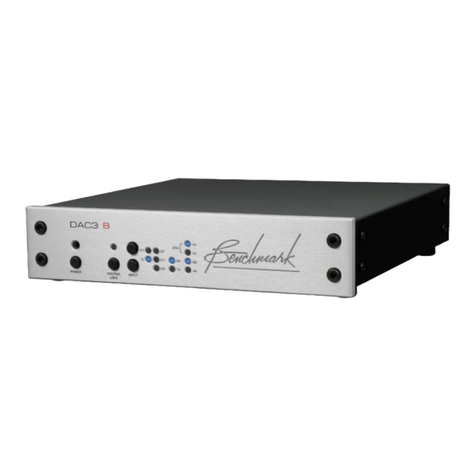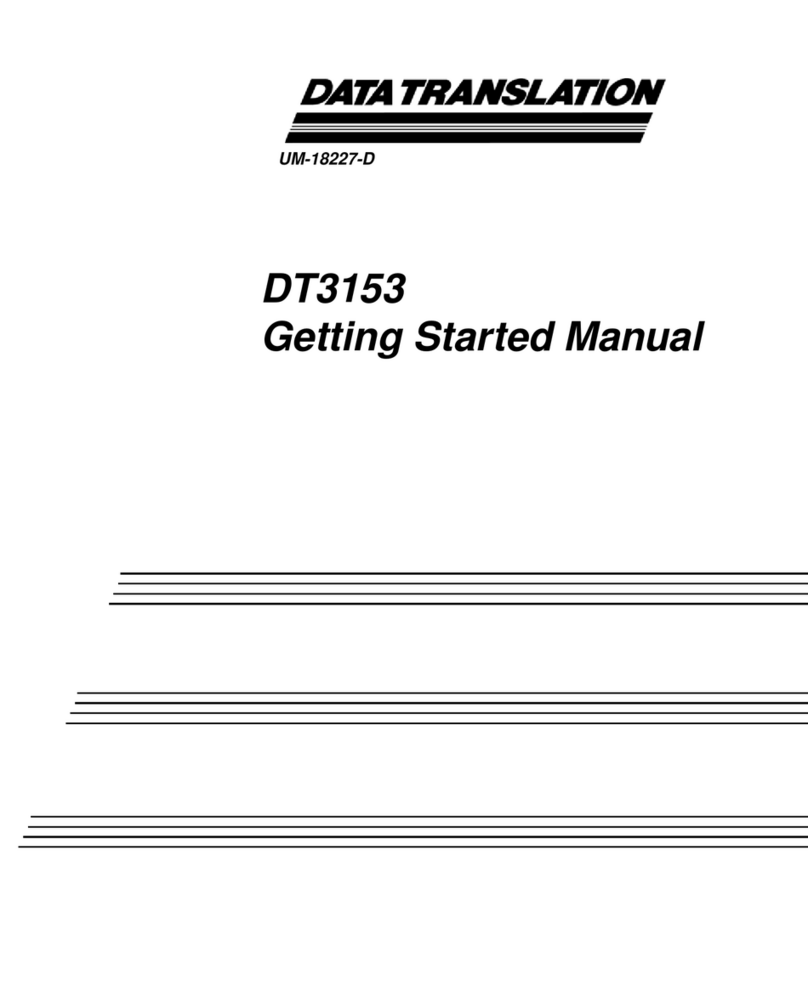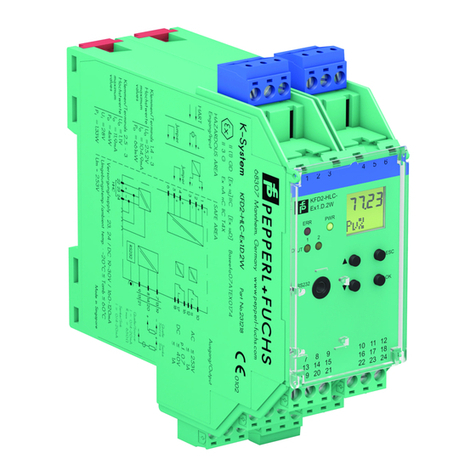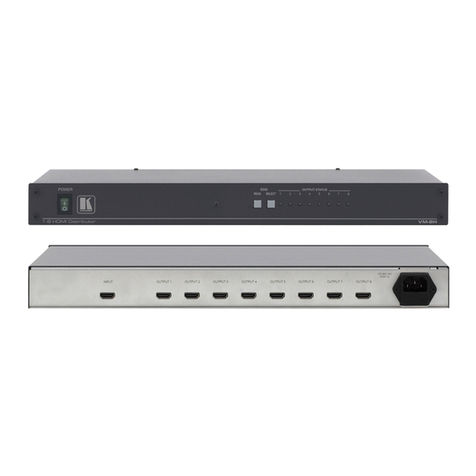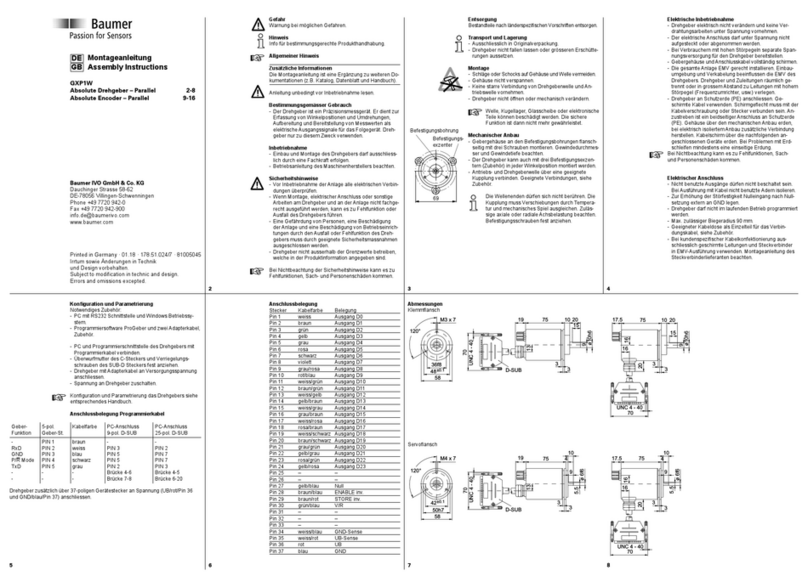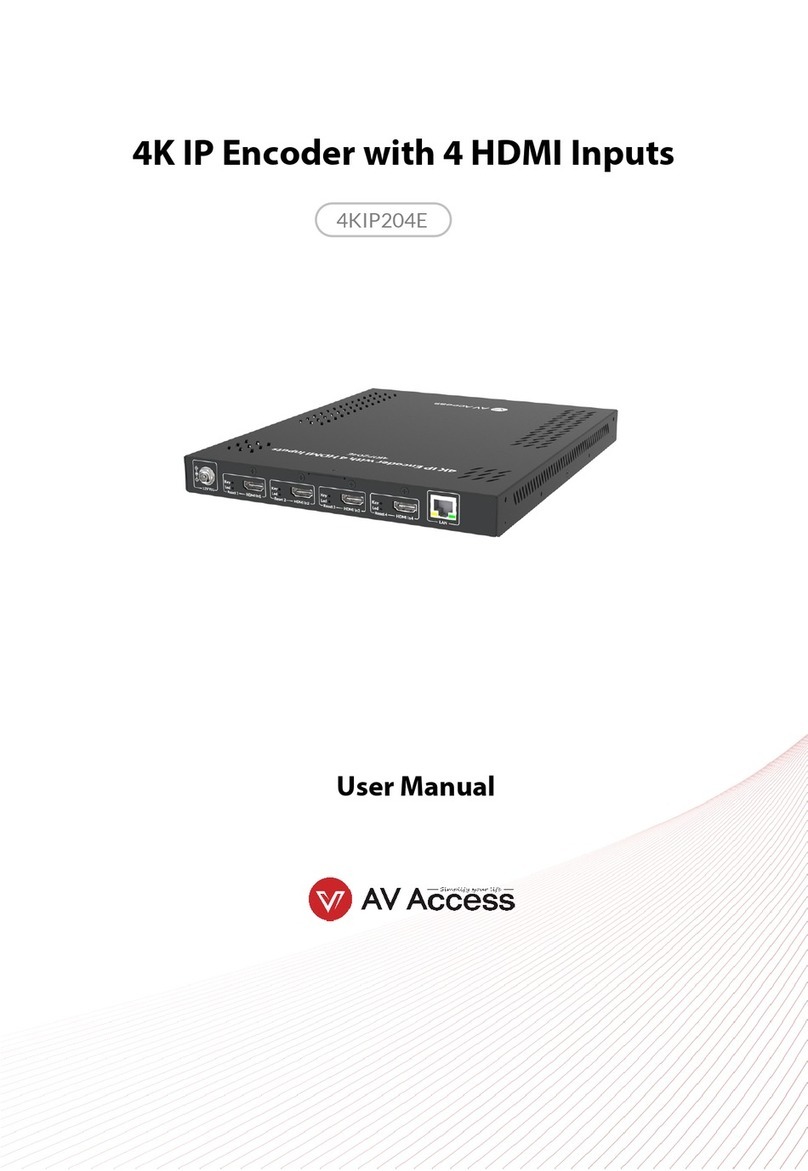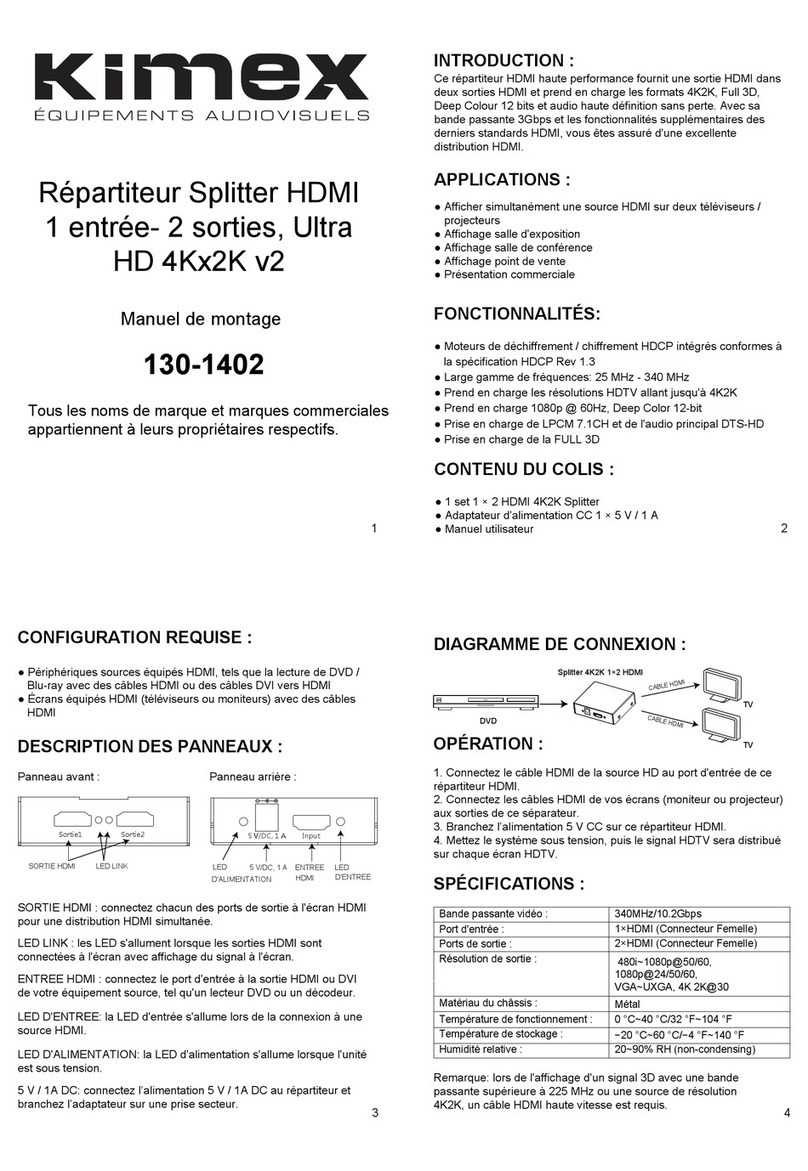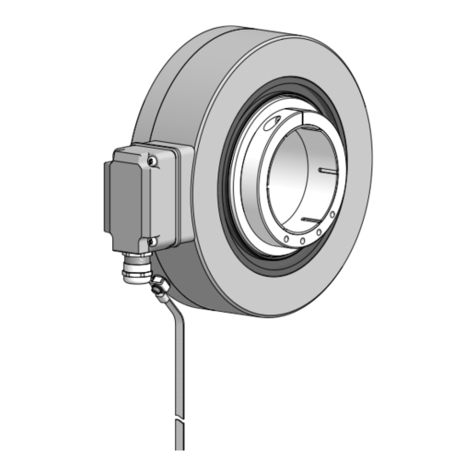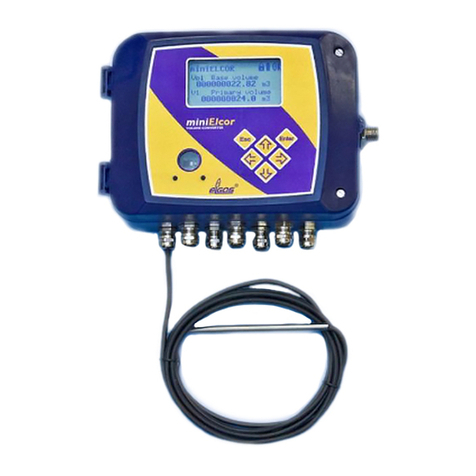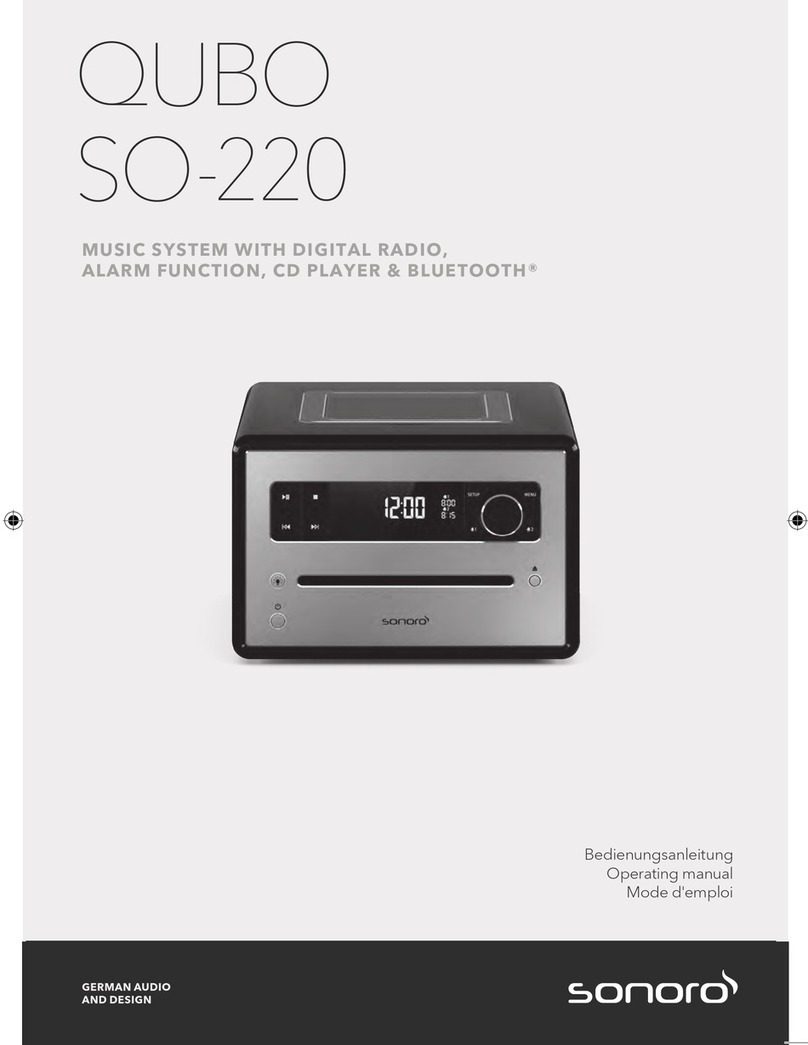Benchmark DAC1 HDR User manual

Benchmark Media Systems, Inc.
DAC1
Instruction Manual
2-Channel 24-bit 96 kHz
Audio Digital-to-Analog Converter

Benchmark Media Systems, Inc.
DAC 1 - Manual - Rev B.doc Page 2 of 37 1/2/2003
Revision History:
Revision Filename Date Author
A DAC1 – Manual – Rev A. Doc 10/01/02 John Siau, Allen Burdick
B DAC1 – Manual – Rev B. Doc 11/27/02 John Siau

Benchmark Media Systems, Inc.
DAC 1 - Manual - Rev B.doc Page 3 of 37 1/2/2003
REVISION HISTORY: 2
SYSTEM OVERVIEW: 4
FEATURE SUMMARY: 5
FRONT PANEL: 6
REAR PANEL: 7
REMOVING TOP COVER: 13
JUMPER LOCATIONS: 14
JUMPER SETTINGS: 15
COMPLIANCE AND SAFETY INFORMATION: 18
CONTACT INFORMATION: 18
WARRANTY: 19
ULTRALOCK™ … WHAT IS IT? 20
DAC1 PERFORMANCE CURVES: 23

Benchmark Media Systems, Inc.
DAC 1 - Manual - Rev B.doc Page 4 of 37 1/2/2003
SYSTEM OVERVIEW:
The DAC1 is a reference quality, 2-channel 96 kHz, 24-bit audio digital-to-analog converter featuring Benchmark’s
UltraLock™ technology. The DAC1 is designed for maximum transparency and is well suited for critical playback
in studio control rooms and in mastering rooms. A compact and rugged enclosure makes the DAC1 an excellent
choice for location recording, broadcast facilities, and mobile trucks. The internal power supply supports all
international voltages and has generous margins for over and under voltage conditions.
Two ¼” headphone jacks are driven with Benchmark’s new HPA2™ headphone amplifier. The HPA2™ is a high-
current amplifier that is capable of driving a wide variety of headphone loads while achieving less than 0.0003%
distortion under load.
The gain control sets the output level of the headphone jacks. It can also be used to control the output level of the
balanced XLR and unbalanced RCA analog outputs. A rear panel switch selects Variable or Calibrated output
levels.
The DAC1 is designed to interface directly to power amps and powered studio monitors in order to provide the
cleanest and shortest path from digital to monitor output. 20-dB pads are provided for interfacing to studio
monitors having high input sensitivity.
Three digital inputs (balanced XLR, coaxial, and optical) are provided and are selected from the front panel. All
inputs accept either professional or consumer formats.
The Benchmark UltraLock™ system is 100% jitter immune. The D/A conversion clock is totally isolated from the
AES/EBU digital audio clocks in a topology that outperforms two-stage PLL designs. In fact, no jitter-induced
artifacts can be detected using an Audio Precision System 2 Cascade test set. Measurement limits include
detection of artifacts as low as -140 dBFS, application of jitter amplitudes as high as 12.75 unit intervals (UI) and
application of jitter over a frequency range of 2 Hz to 200 kHz. Any AES/EBU signal that can be decoded by the
AES/EBU receiver will be reproduced without the addition of any measurable jitter artifacts. In addition, the
receiver IC has been selected for its ability to decode AES/EBU signals in the presence of very high levels of
jitter.
The DAC1 is designed to perform gracefully in the presence of errors and interruptions at the digital audio inputs.
A soft mute circuit eliminates pops when a digital signal is applied. Power management circuitry controls the
muting and resetting of all digital circuits upon removal and application of power. Audio is present at the outputs
only 60 ms after applying a digital input signal and only 500 ms after applying power to the unit.
The DAC1 is designed to avoid all unnecessary mute scenarios. Muting is only enabled upon loss of power, or
when digital transmission errors occur. The DAC1 does not mute when the input data is all zeros. Consequently,
no audio is lost when an audio transient follows full silence. Furthermore, the DAC1 SNR specifications represent
the true system performance, not just the performance of an output mute circuit.
The DAC1 will operate even when sample rate status bits are set incorrectly. Sample rate is determined by
measuring the incoming signal. Lack of sample rate status bits or incorrectly set status bits will not cause loss of
audio.
The DAC1 is phase accurate between channels, and between other DAC1 boxes.
A fully digital de-emphasis circuit supports 44.1, 48, 88.2 and 96 kHz and is automatically enabled in response to
the pre-emphasis status bits of consumer format digital signals.

Benchmark Media Systems, Inc.
DAC 1 - Manual - Rev B.doc Page 5 of 37 1/2/2003
FEATURE SUMMARY:
• XLR balanced, BNC coaxial, and Toslink optical digital inputs – front panel switch selectable
• High level, +4 dBu balanced analog outputs, +29 dBu maximum output level
• Jumper-selected 10, 20, or 30 dB pads on balanced outputs
• -10 dBV unbalanced outputs, +21 dBu maximum output level
• Two HPA2™ high-current, high-output ¼” headphone jacks
• Front panel knob controls all analog outputs or just the headphone outputs (selected with rear-panel switch)
• Analog output mute function on rear-panel switch
• Preset output levels use multi-turn trimmers – one 10-turn trimmer per output, 20 dB Range, 2 dB/turn
• Total jitter immunity with Benchmark, phase-accurate UltraLock™ technology
• Two Error LEDs, (no digital input, non-PCM digital input)
• Power Indicator LED
• THD+N = -107 dB, 0.00045% @ -3 dBFS input, -105 dB, 0.00056% @ 0 dBFS input
• Automatic de-emphasis in consumer mode at 44.1, 48, 88.2, or 96 kHz when pre-emphasis bit is set
• Reliable and consistent performance under all operating conditions
• 115V, 230V, 50-60 Hz international power supply with very wide operating range
• Low radiation toroidal power transformer eliminates hum and line related interference
• Low power consumption (8 Watts typical program, 16 Watts peak)
• Meets FCC Class B and CE emissions requirements

Benchmark Media Systems, Inc.
DAC 1 - Manual - Rev B.doc Page 6 of 37 1/2/2003
FRONT PANEL:
STATUS DISPLAY:
Power - (Blue LED) indicates the presence of power within the DAC1
Error - (Red LED) indicates out of sample range, too low or no digital input signal
Non PCM - (Red LED) indicates a digital audio signal that cannot be decoded by the DAC1 (such as Dolby AC3)
INPUT SELECTOR SWITCH – Three Position Toggle:
Coaxial - Selects the unbalanced digital signal from the BNC coaxial input
XLR - Selects the balanced digital signal from the XLR type connector at the rear panel
Optical - Selects the digital signal from the TOSLINK optical input at the rear panel
HPA2™STEREO HEADPHONE JACKS:
There are two stereo headphone jacks. These allow two listeners to monitor and compare notes on what is
heard. We recommend using identical headphones because headphone sensitivities can differ significantly. The
front panel gain control adjusts the level at both jacks. Benchmark’s HPA2™ is unsurpassed in its ability to deliver
high current at high output levels without distortion. The HPA2™ delivers the full rated performance of the DAC1
into a pair of 60 Ωheadphones. The HPA2™ is fully protected against short circuits and overloads.
VARIABLE GAIN CONTROL:
The front-panel gain control always controls the output level of the headphone jacks. It can also be used to control
the output levels of the balanced XLR and unbalanced RCA analog outputs. A rear panel switch selects Variable
or Calibrated output levels. In Variable mode the analog output levels are controlled from the front panel control.
In Calibrated mode the analog output levels are controlled from a pair of 10-turn trimmers (located on the rear
panel).
RACK MOUNT HOLES:
For ease of mounting, the front panel of the DAC1 has rack mount holes that are machined to conform to
standard rack mount dimensions. The width of the DAC1 panel is exactly ½ that of a standard 19” panel. The
DAC1 is one rack unit high. Either ear of the DAC1 can be mounted directly to a standard 19” rack. A machined
junction block connects the other ear to a ½ width blank panel, another DAC1, or future ½ width Benchmark
products. When joined, the two units form a single rigid 19” panel that can be installed in any standard 19” rack.

Benchmark Media Systems, Inc.
DAC 1 - Manual - Rev B.doc Page 7 of 37 1/2/2003
REAR PANEL:
OUTPUT LEVEL SWITCH – Three Position Toggle:
Calibrated (UP) – Analog output levels are controlled by 10-turn rear-panel trim controls
Off (CENTER) – Analog outputs are muted, headphone outputs remain active
Variable (DOWN) – Analog output levels are controlled by front panel gain control
The Output Level switch does not affect the operation of the headphone jacks (the headphone outputs are never
disabled, and the headphone level is always controlled from the front panel).
CALIBRATION POTENTIOMETERS:
The calibration potentiometers are 10-turn trimmers and are accessible through the rear panel using a small
screwdriver. These trimmers provide a 2 dB per rotation adjustment with a total control range of + 9 to +29 dBu at
0 dBFS (full-scale digital input). Factory calibration has been set so that the output level at the balanced XLR
connectors is +4 dBu @ -20 dBFS (+4 dBu when the digital input signal is at -20 dBFS, and +24 dBu at 0 dBFS).
This is the most common reference level for studio applications. The factory-preset levels may be increased by 5
dB or decreased by 15 dB in order to conform to other studio reference levels. This range of levels is also well
suited for direct connection to the balanced line-level inputs on most power amplifiers. Most professional
equipment will work well at these levels.
Note: The DAC1 is shipped with the Output Level switch set to Variable. The Calibration Potentiometers
have no effect on the output levels when this switch is set to Variable.
Caution: Most powered studio monitors require signal levels that are much lower than standard studio levels. All
DAC1 converters produced after 12/01/02 are equipped with internal jumper-selected 10, 20, and 30 dB
attenuators. DAC1 converters produced prior to 12/01/02 were shipped with external 20 dB attenuator cables.
Most powered monitors will require 20 dB attenuation when connected directly to the DAC1 XLR outputs.

Benchmark Media Systems, Inc.
DAC 1 - Manual - Rev B.doc Page 8 of 37 1/2/2003
ANALOG OUTPUTS:
Balanced Analog Outputs:
Left and Right balanced outputs are provided on Neutrik™ gold-pin male XLR jacks. The output levels may be
controlled from the front panel, or may be set to fixed levels using the rear-panel Calibration Potentiometers.
The output impedance of the XLR outputs is 60 Ωwhen the output pads are disabled. The low output impedance
makes these outputs well suited for driving up to 680 feet of cable (assuming 32 pF/foot). If the output pads are
enabled, the output impedance will be higher, and the maximum allowable cable length must be reduced as
shown in Table 1(assuming 32 pF/foot and a maximum allowable loss of 0.1 dB at 20 kHz).
Table 1 - Cable Drive Capability
Balanced Output Drive Capability:
Attenuator Output Maximum Loss in dB
Setting (dB) Impedance Cable (ft) at 20 kHz
0 60 680 0.1
10 1600 26 0.1
20 500 82 0.1
30 160 255 0.1
Unbalanced Output Drive Capability:
Output Maximum Loss in dB
Impedance Cable (ft) at 20 kHz
2500 16 0.1
XLR pin 2 = + Audio Out
XLR pin 3 = - Audio Out
XLR pin 1 = Cable Shield (grounded directly to the chassis to prevent internal ground loops)
Caution: If the balanced XLR outputs are wired to an unbalanced input (using special adapter cables), pin 3 must
be left floating. Shorting pin 3 to ground will cause very high levels of distortion.
Caution: The XLR outputs are studio-grade line-level outputs and should not be plugged into microphone inputs
without the use of the internal 20 or 30 dB pads (or a suitable external pad).
Unbalanced Analog Outputs:
Left and Right unbalanced outputs are provided on standard RCA style jacks. The left channel output connector
is white, and right channel output connector is red. The output levels may be controlled from the front panel, or
may be set to fixed levels using the rear-panel Calibration Potentiometers. The XLR attenuators do not have
any effect on the level of the RCA outputs. The RCA output levels are 12 dB lower than the XLR outputs (when
the internal XLR attenuators are disabled). When the XLR outputs are calibrated to +4 dBu at –20 dBFS, the RCA
outputs will conform to the -10 dBV convention for consumer grade equipment. The output impedance at the
RCA jacks is 2.5 kΩand is high enough to allow mono summing with a “Y” cable and high enough to protect the
DAC1 from wiring errors (wiring errors on the RCA outputs will not cause distortion on the XLR outputs).
The 2.5 kΩunbalanced outputs have several advantages when compared to 15 kΩunbalanced outputs (found on
consumer audio equipment). Low output impedance reduces the high-frequency attenuation effects of cable
capacitance, and may reduce noise and distortion in certain installations.
Note: The RCA outputs should not be used to drive cables exceeding 16 feet (see Table 1).

Benchmark Media Systems, Inc.
DAC 1 - Manual - Rev B.doc Page 9 of 37 1/2/2003
DIGITAL INPUTS:
There are three digital inputs on the DAC1. These inputs are selected from a front panel toggle switch. All of the
inputs can decode AES/EBU and S/PDIF input signals in either professional or consumer formats. The DAC1 will
not decode AC3 signals. A red Non PCM Error LED will illuminate when AC3 or other non-PCM input signals are
connected to the selected digital input. Internal jumpers can be used to disable the front panel selector switch.
These jumpers allow the permanent selection of any one of the three digital inputs. This feature is useful for
applications where the DAC1 has a dedicated function in a critical audio path.
XLR Digital Input:
This input uses a gold-pin Neutrik™ female XLR connector. The input is balanced and has a 110 Ωinput
impedance. This input is DC isolated, transformer coupled, current limited, and diode protected. It is designed to
accept standard 4 Vpp AES signals, and will work reliably with levels as low as 300 millivolts. Receive errors will
occur (and the DAC1 will mute) when the peak-to-peak input voltage is less than about 160 millivolts.
Coaxial Digital Input:
The coaxial input uses a female BNC connector that is securely mounted directly to the rear panel. The input
impedance is 75 Ω. This input is DC isolated, transformer coupled, current limited, and diode protected.
Like the other digital inputs, this input accepts AES/EBU or S/PDIF digital audio formats. The BNC connector is
specified by the AES3-id and SMPTE 276M standards for 75 Ω1 Vpp digital audio signals and is commonly used
in video production facilities. IEC 609588-3 specifies the use of an RCA type connector for 75 Ω0.5 Vpp
consumer-format digital audio signals (commonly known as S/PDIF). The coaxial input on the DAC1 is designed
to accept either type of signal. We have chosen to use a BNC connector because of its superior reliability. The
DAC1 comes with a BNC-to-RCA adapter to allow easy interface with consumer equipment.
The BNC input has a 75 Ωinternal termination that may be disabled by removing a jumper. This termination is
required for normal operation, but may be removed if the user wishes to loop a single coaxial feed through several
other pieces of equipment. A 75 Ωtermination must be applied at the last device on the loop, and there should
be a combined total of less than 6 feet of cable between the first and last receive device.
Optical Input:
The optical input connector is manufactured by Toshiba and is commonly known as a Toslink connector. Toslink
optical connections work well at sample rates up to 96 kHz but may be unreliable or non-functional at higher
sample rates (such as 192 kHz). We suggest using either the XLR or coaxial digital inputs at sample rates above
96 kHz.
AC POWER INPUT CONNECTOR AND FUSE HOLDER:
The AC power input uses a standard IEC type connector. One USA compatible power cord is included with the
DAC1. IEC style power cords in country specific configurations are generally available in your locality. If you are
unable to purchase a proper power cord for the country in which you live, we may, for an additional charge, be
able to locate one for you. Please contact the sales department at Benchmark Media Systems for further
information.
The fuse holder is built into a drawer next to the IEC power connector. The drawer requires two 7 X 20 mm fuses.
The drawer includes a voltage selection switch with two settings (115 V and 230 V). The fuse rating for the 115-
volt setting is 0.50 Amp. The rating for the 230-volt setting is 0.25 Amp.
The AC input has a very wide input voltage range and can operate over a frequency range of 50 to 60 Hz. At
“115V”, the DAC1 will operate normally over a range of 90 to 140 VAC. At “230V” the DAC1 will operate normally
over a range of 175 to 285 VAC.
Caution: Always install the correct fuses when changing the voltage setting. Always insure that the voltage
setting is correct for your locality.

Benchmark Media Systems, Inc.
DAC 1 - Manual - Rev B.doc Page 10 of 37 1/2/2003
SPECIFICATIONS:
DIGITAL INPUTS:
Number of Digital Inputs (switch selected): 3, (XLR, Coaxial, Toslink)
Number of Audio Channels: 2
Input Sample Frequency Range: 28 to 195 kHz
Maximum Input Word Length 24-bits
Digital Input Impedance on XLR input: 110 Ω
Digital Input Impedance on Coaxial input (Jumper Selected): 75 Ωor Hi-Z (Bridging)
Transformer Coupled Digital Inputs: Yes
DC Blocking Capacitors on Digital Inputs: Yes
Transient and Over-Voltage Protection on Digital Inputs: Yes
Minimum Digital Input Level: 300 mVpp on XLR, 150 mVpp on Coaxial
Jitter Tolerance (With no Measurable Change in Performance): >12.75 UI sine, 100Hz-10 kHz
> 3.5 UI sine at 20 kHz
> 1.2 UI sine at 40 kHz
> 0.4 UI sine at 80 kHz
> 0.29 UI sine at 90 kHz
> 0.25 UI sine above 160 kHz
Jitter Attenuation Method: Benchmark UltraLock™
BALANCED ANALOG OUTPUTS:
Number of Balanced Analog Outputs: 2
Output Connector: Gold-Pin Neutrik™ male XLR
Output Impedance: 60 Ω
Output Level Calibration Controls: 10-turn trimmers (1 per output)
Calibration Adjustability: 2 dB / turn
Output Level Range (at 0 dBFS) In “Calibrated” Mode: +9 dBu to +29 dBu (Attenuator off)
-1 dBu to +19 dBu (Attenuator = 10 dB)
-11 dBu to +9 dBu (Attenuator = 20 dB)
-21 dBu to -1 dBu (Attenuator = 30 dB)
Output Level Range (at 0 dBFS) In “Variable” Mode: Off to +29 dBu (Attenuator off)
Off to +19 dBu (Attenuator = 10 dB)
Off to +9 dBu (Attenuator = 20 dB)
Off to -1 dBu (Attenuator = 30 dB)
Output Level Variation with Sample Rate (44.1 kHz vs. 96 kHz): < +/- 0.006 dB
UNBALANCED ANALOG OUTPUTS:
Number of Balanced Analog Outputs: 2
Output Connector: RCA
Output Impedance: 2.5 kΩ
Output Level Calibration Controls: Shared with Balanced Outputs
Output Level Range (at 0 dBFS) In “Calibrated” Mode: -3 dBu to +17 dBu
Output Level Range (at 0 dBFS) In “Variable” Mode: Off to +17 dBu
Calibration Adjustability: 2 dB / turn
Output Level Variation with Sample Rate (44.1 kHz vs. 96 kHz): < +/- 0.006 dB
HPA2™ HEADPHONE OUTPUTS:
Number of Headphone Outputs: 2
Output Connector: ¼” TRS
Output Impedance: 0 Ω
Output Level Control: Stereo Control on Front Panel
Output Level Range (at 0 dBFS) into 60 ΩLoad: Off to +21 dBu

Benchmark Media Systems, Inc.
DAC 1 - Manual - Rev B.doc Page 11 of 37 1/2/2003
AUDIO PERFORMANCE:
Fs = 44.1 to 96 kHz, 20 to 20 kHz BW, 1 kHz test tone, 0 dBFS = +24 dBu (unless noted):
SNR – A-Weighted, (0 dBFS = +20 to +29 dBu): 116 dB
SNR – Unweighted, (0 dBFS = +20 to +29 dBu): 114 dB
SNR – A-Weighted at low gain, (0 dBFS = +9 to +18 dBu): 114 dB
THD+N, 1 kHz at 0 dBFS: -105 dBFS, -105 dB, 0.00056%
THD+N, 1 kHz at –1 dBFS: -107 dBFS, -106 dB, 0.00050%
THD+N, 1 kHz at –3 dBFS: -110 dBFS, -107 dB, 0.00045%
THD+N, 20 to 20 kHz test tone at –3 dBFS: -110 dBFS, -107 dB, 0.00045%
Frequency Response at Fs=48 kHz: +/- 0.1 dB (20 to 20 kHz)
-0.02dBat10Hz
-0.20dBat20kHz
Frequency Response at Fs=96 kHz: +/- 0.1 dB (20 to 20 kHz)
-0.02dBat10Hz
-0.20dBat20kHz
-0.85dBat40kHz
-2.5dBat45kHz
Crosstalk: -100 dB at 20 kHz
-125 dB at 1 kHz
-130 dB at 20 Hz
Maximum Amplitude of Jitter Induced Sidebands: < -141 dB
(10 kHz 0 dBFS test tone, 12.75 UI sinusoidal jitter at 1 kHz)
Maximum Amplitude of Spurious Tones with 0 dBFS test signal: < -126 dB
Maximum Amplitude of Idle Tones: < -128 dB
Maximum Amplitude of AC line related Hum & Noise: < -126 dB
Interchannel Differential Phase (Stereo Pair): +/- 0.5 degrees at 20 kHz
Interchannel Differential Phase (Between DAC1 Units): +/- 0.5 degrees at 20 kHz
Delay (Digital Input to Analog Output): 1.01 mS + (48/Fs)
2.10 ms at 44.1 kHz
2.01 ms at 48 kHz
1.55 ms at 88.2 kHz
1.51 ms at 96 kHz
Maximum Lock Time – after Fs change: 100 mS
Soft Mute Ramp Up/Down Time: 10 mS
Mute on Receive Error: Yes
Mute on Lock Error: Yes
Mute on Idle Channel: No
50/15 uS De-Emphasis Enable: Automatic in Consumer Mode
De-Emphasis Method: Digital IIR
De-Emphasis Supported at: Fs = 32, 44.1, 48, and 96 kHz

Benchmark Media Systems, Inc.
DAC 1 - Manual - Rev B.doc Page 12 of 37 1/2/2003
GROUP DELAY (LATENCY):
Delay from digital input to analog output is a function of sample rate:
2.72 ms at 28 kHz
2.51 ms at 32 kHz
2.10 ms at 44.1 kHz
2.01 ms at 48 kHz
1.55 ms at 88.2 kHz
1.51 ms at 96 kHz
1.45 ms at 108 kHz
The delay can be calculated using the following formula:
Delay = 1.01 mS + (48/Fs)
Where Fs = the sample rate in Hz.
LED STATUS INDICATORS:
LED Location: Front Panel
Power: (AC power is connected and +5 V supply is operating) 1 (Blue)
Error: (Error on the active digital input) 1 (Red)
Non PCM: (Non-compatible digital audio format on active input) 1 (Red)
AC POWER REQUIREMENTS:
50-60 Hz
8 Watts Idle
8 Watts Typical Program
16 Watts Maximum
Fuses (2 required) – 7 X 20 mm
0.5 Amp – 100 V to 130 VAC
0.25 Amp – 200 V to 260 VAC
Input Operating Voltage Range – VAC RMS
115 V setting – 90 V min, 140 V max
230 V setting – 175 V min, 285 V max
DIMENSIONS:
½ Rack Wide, 1 RU High
8.5” (216 mm) Depth behind front panel
9.33” (237 mm) Overall depth including connectors but without power cord or BNC-to-RCA adapter.
9.5” (249 mm) Wide
1.725” (44.5 mm) High
WEIGHT:
DAC1only: 3.5lb.
DAC1 with power cord, BNC-to-RCA adapter, and manual: 4.5 lb.
Rack mount kit (blank panel, junction block, and rack-mount screws): 0.32 lb.
Shipping weight: 7 lb.

Benchmark Media Systems, Inc.
DAC 1 - Manual - Rev B.doc Page 13 of 37 1/2/2003
REMOVING TOP COVER:
The DAC1 has a removable cover. This cover provides access to the jumper settings on the PCB. The DAC1
contains static sensitive components and should only be opened by qualified technicians. Static discharge may
cause component failures, may affect the long-term reliability, or may degrade the audio performance. Use a
static control wrist strap when changing jumper settings.
Caution:
• Disconnect AC power by unplugging the power cord at the back of the DAC1.
• Remove only the 8 screws holding the cover (4 on each side).
• Do not remove any screws on front or rear panels.
• Never remove the power entry safety cover in the rear corner of the DAC1.
• Use a static control wrist strap when changing jumper settings.

Benchmark Media Systems, Inc.
DAC 1 - Manual - Rev B.doc Page 14 of 37 1/2/2003
JUMPER LOCATIONS:
Figure 1. – DAC1 Jumper Locations

Benchmark Media Systems, Inc.
DAC 1 - Manual - Rev B.doc Page 15 of 37 1/2/2003
JUMPER SETTINGS:
Jumpers are provided for special applications. A 2-pin jumper plug at header P2 can be moved in order to disable
the front-panel input selection switch. A jumper at JP7 can be removed to disable the 75 Ωtermination on the
coaxial digital input. Four 8-pin headers (P5, P6, P7, and P8) allow selection of the output level at the XLR jacks.
Caution: Do not change any jumpers other than P2, P5, P6, P7, P8, and JP7. All other jumpers are for test
purposes only. Jumpers must always be installed at JP1, JP2, JP5, and JP6 (power supply enable jumpers).
Jumpers should not be installed on header P9.
Input Source Select Jumper (P2):
A 2-pin jumper on header P2 (see Photo 1) can be used to disable the front-panel source-selection switch. This
feature is useful when the DAC1 is in a critical audio path, and only one of the three digital inputs will be used. In
such an application, the digital source selection can be made using the jumper on header P2. This can prevent
loss of audio due to operator error. The 2-pin jumper allows selection of:
• Switchable Input *** (digital input selection using front-panel switch) – (Jumper plug between pins 1 and 2 of
the header)
• Optical Input Only (front-panel switch is disabled) – (Jumper plug between pins 3 and 4 of the header)
• Coaxial Input Only (front-panel switch is disabled) – (Jumper plug between pins 5 and 6 of the header)
• XLR Input Only (front-panel switch is disabled) – (Jumper plug between pins 7 and 8 of the header)
*** = Factory Default
P2
12
34
56
78
Switch Enabled ***
Optical Only
Coaxial Only
XLR Only
Photo 1 - Input Source Select Jumper (P2)

Benchmark Media Systems, Inc.
DAC 1 - Manual - Rev B.doc Page 16 of 37 1/2/2003
Coaxial Input Impedance Jumper (JP7):
The Coaxial (BNC) input has a 75Ωinternal termination that may be disabled by removing the 2-pin jumper at JP7
(see Photo 2). This termination is required for normal operation, but may be removed if the user wishes to loop a
single coaxial feed through several other pieces of equipment (using a BNC “T” adapter on the DAC1). A 75 Ω
termination must be applied at the last device on the loop, and there should be a combined total of less than 6
feet of cable between the first and last receive device. JP7 should be configured as follows:
• 75ΩInput Impedance*** (Jumper Installed)
• High-Z Input Impedance (Jumper Removed)
*** = Factory Default
Photo 2 - BNC Input Impedance Jumper (JP7)

Benchmark Media Systems, Inc.
DAC 1 - Manual - Rev B.doc Page 17 of 37 1/2/2003
XLR Output Attenuation Jumpers (P5, P6, P7, and P8):
One pair of 8-pin headers controls the output level at each XLR jack as follows:
• 0 dB ***(Attenuator disabled) – (Jumper plug between pins 1 and 2 of each header)
• -10 dB – (Jumper plug between pins 3 and 4 of each header)
• -20 dB – (Jumper plug between pins 5 and 6 of each header)
• -30 dB – (Jumper plug between pins 7 and 8 of each header)
*** = Factory Default
Photo 3 - XLR Output Attenuation Jumpers (P5, P6, P7, and P8)
P6
12
34
56
78
LEFT
0 dB ***
-10 dB
-20 dB
-30 dB
P5
12
34
56
78
P8
12
34
56
78
RIGHT
0 dB ***
-10 dB
-20 dB
-30 dB
P7
12
34
56
78

Benchmark Media Systems, Inc.
DAC 1 - Manual - Rev B.doc Page 18 of 37 1/2/2003
COMPLIANCE and SAFETY INFORMATION:
FCC Class B Compliance:
This device complies with part 15 of the FCC Rules. Operation is subject to the following two conditions:
(1) This device may not cause harmful interference, and
(2) This device must accept any interference received, including interference that may cause undesired operation.
Safety Information:
Do NOT service or repair this product unless properly qualified. Only a qualified technician should perform
repairs.
For continued fire hazard protection, fuses should be replaced ONLY with the exact value and type as indicated
on the rear panel.
Do NOT substitute parts or make any modifications without the written approval of Benchmark Media Systems,
Inc. Doing so may create safety hazards and void the warranty.
CONTACT INFORMATION:
Benchmark Media Systems, Inc.
5925 Court Street Road
Syracuse, NY 13206-1707
USA
(315) 437-6300
www.benchmarkmedia.com

Benchmark Media Systems, Inc.
DAC 1 - Manual - Rev B.doc Page 19 of 37 1/2/2003
WARRANTY:
The Benchmark 5 Year Warranty
Benchmark Media Systems, Inc. warrants its products to be free from defects in material and workmanship under normal use and
service for a period of five years from the date of delivery. This warranty extends only to the original purchaser. This warranty does
not apply to fuses, lamps, batteries, or any products or parts that have been subjected to misuse, neglect, accident, or abnormal
operating conditions.
In the event of failure of a product under this warranty, Benchmark Media Systems, Inc. will repair, at no charge, the product
returned to its factory. Benchmark Media Systems, Inc. may, at its option, replace the product in lieu of repair. If the failure has
been caused by misuse, neglect, accident or abnormal operating conditions, repairs will be billed at the normal shop rate. In such
cases, an estimate will be submitted before work is started, if requested by the customer.
The foregoing warranty is in lieu of all other warranties, expressed or implied, including but not limited to any implied warranty of
merchantability, fitness or adequacy for any particular purpose or use. Benchmark Media Systems, Inc. shall not be liable for any
special, incidental, or consequential damages. This limited warranty gives the consumer-owner specific legal rights, and there may
also be other rights that vary from state to state.
A return authorization is required when sending products for repair. They must be shipped to Benchmark Media Systems, Inc.
prepaid and preferably in their original shipping carton. A letter should be included addressed to the customer service department,
giving full details of the difficulty.

Benchmark Media Systems, Inc.
DAC 1 - Manual - Rev B.doc Page 20 of 37 1/2/2003
UltraLock™ … What is It?
Accurate 24-bit audio conversion requires a very low-jitter conversion clock. Jitter can very easily turn a 24-bit
converter into a 16-bit converter (or worse). There is no point in buying a 24-bit converter if clock jitter has not
been adequately addressed.
Jitter is present on every digital audio interface. This type of jitter is known as “interface jitter” and it is present
even in the most carefully designed audio systems. Interface jitter accumulates as digital signals travel down a
cable and from one digital device to the next. If we measure interface jitter in a typical system we will find that it
10 to 10,000 times higher than the level required for accurate 24-bit conversion. Fortunately, this interface jitter
has absolutely no effect on the audio unless it influences the conversion clock in an analog-to-digital converter
(ADC) or in a digital-to-analog converter (DAC).
Many converters use a single-stage Phase Lock Loop (PLL) circuit to derive their conversion clocks from
AES/EBU, Wordclock, or Superclock reference signals. Single-stage PLL circuits provide some jitter attenuation
above 5 kHz but none below 5 kHz. Unfortunately, digital audio signals often have their strongest jitter
components at 2 kHz. Consequently, these converters can achieve their rated performance only when driven
from very low jitter sources and through very short cables. It is highly unlikely that any converter with a single-
stage PLL can achieve better than 16-bits of performance in a typical installation. Specified performance may be
severely degraded in most installations.
Better converters usually use a two-stage PLL circuit to filter out more of the interface jitter. In theory, a two-
stage PLL can remove enough of the jitter to achieve accurate 24-bit conversion (and some do). However, two-
stage PLL circuits are not all created equal. Many two-stage PLLs do not remove enough of the low-frequency
jitter. In addition, two-stage PLL circuits often require several seconds to lock to an incoming signal. Finally, a
two-stage PLL may fail to lock when jitter is too high, or when the reference sample frequency has drifted.
UltraLock™ converters exceed the jitter performance of two-stage PLL converters, and are free from the slow-
lock and no-lock problems that can plague two-stage PLL designs. UltraLock™ converters are 100% immune to
interface jitter under all operating conditions. No jitter-induced artifacts can be detected using an Audio Precision
System 2 Cascade test set. Measurement limits include detection of artifacts as low as –140 dBFS, application of
jitter amplitudes as high as 12.75 UI, and application of jitter over a frequency range of 2 Hz to 200 kHz. Any
AES/EBU signal that can be decoded by the AES/EBU receiver will be reproduced without the addition of any
measurable jitter artifacts.
The DAC1, DAC-104 and the ADC-104 employ Benchmark’s new UltraLock™ technology to eliminate all jitter-
induced performance problems. UltraLock™ technology isolates the conversion clock from the digital audio
interface clock. Jitter on a DAC digital audio input, or an ADC reference input can never have any measurable
effect on the conversion clock of an UltraLock™ converter. In an UltraLock™ converter, the conversion clock is
never phase-locked to a reference clock. Instead the converter oversampling-ratio is varied with extremely high
precision to achieve the proper phase relationship to the reference clock. Interface jitter cannot degrade the
quality of the audio conversion. Specified performance is consistent and repeatable in any installation!
How does conversion clock jitter degrade converter performance?
Problem #1: Jitter phase modulates the audio signal. This modulation creates sidebands (unwanted tones)
above and below every tone in the audio signal. Worse yet, these sidebands are often widely separated from the
tones in the original signal.
Jitter-induced sidebands are not musical in nature because they are not harmonically related to the original audio.
Furthermore, these sidebands are poorly masked (easy to hear) because they can be widely separated above
and below the frequencies of the original audio tones. In many ways, jitter induced distortion resembles
intermodulation distortion (IMD). Like IMD, jitter induced distortion is much more audible than harmonic distortion,
and more audible than THD measurements would suggest.
Other manuals for DAC1 HDR
2
Table of contents
Other Benchmark Media Converter manuals
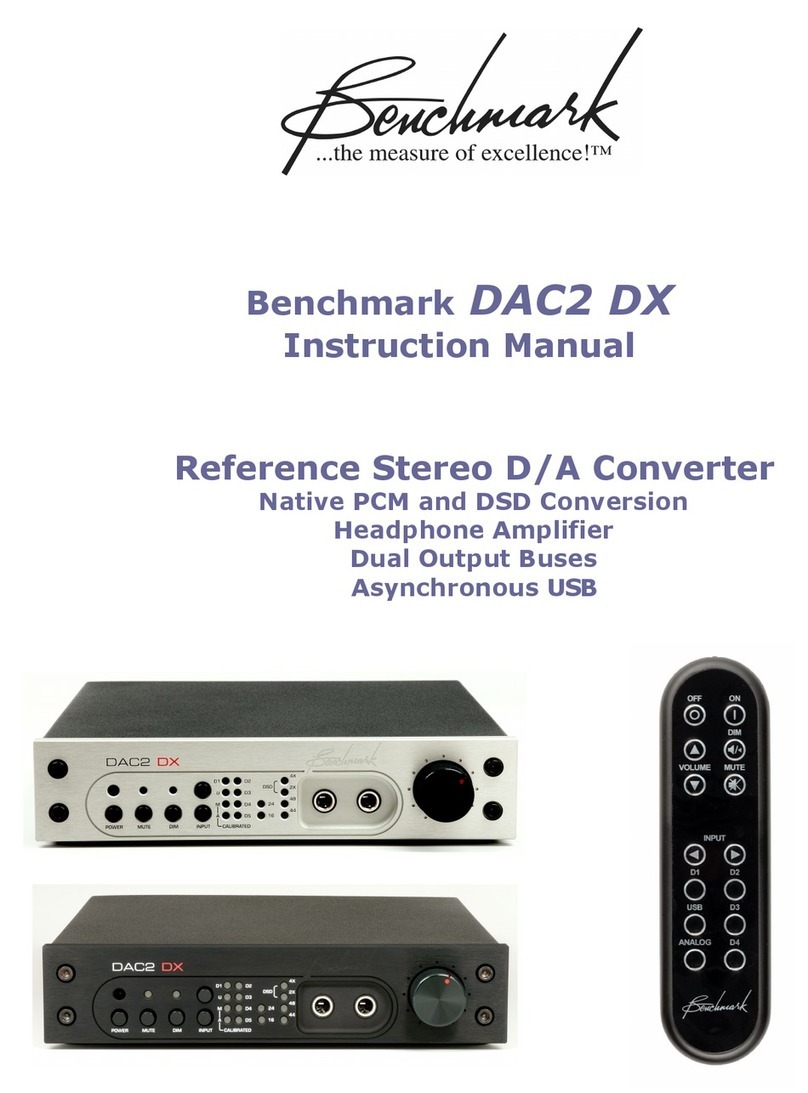
Benchmark
Benchmark DAC2 DX User manual
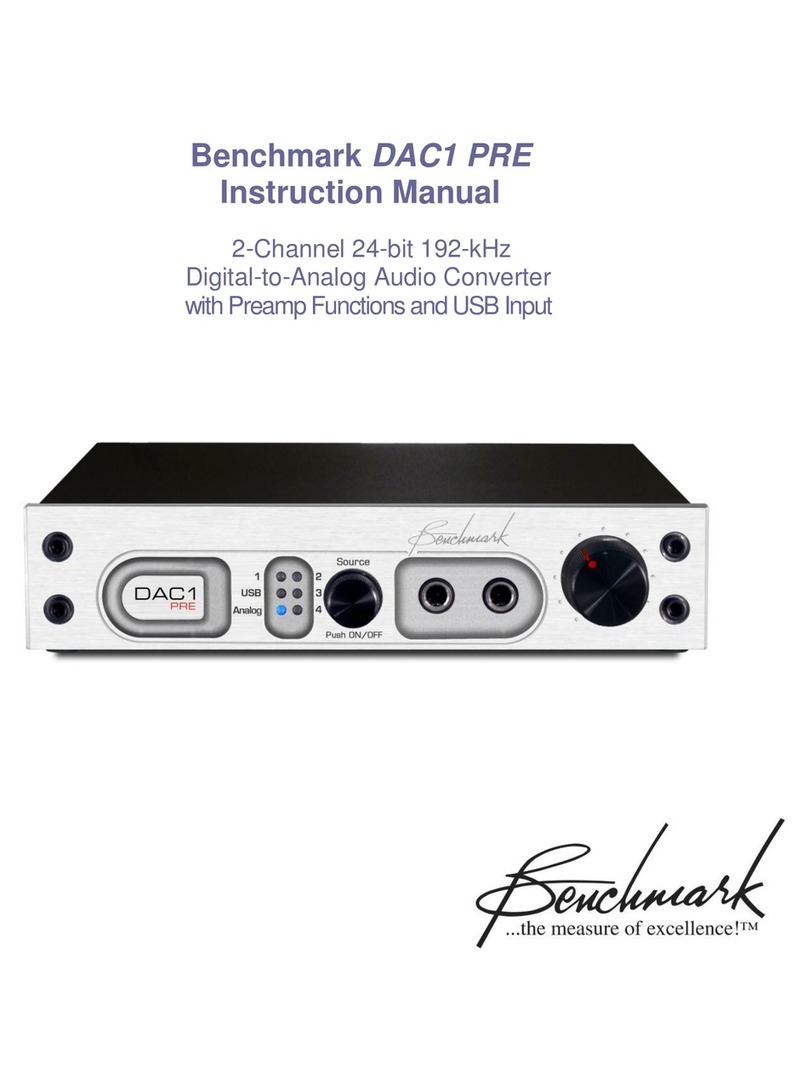
Benchmark
Benchmark DAC1 PRE User manual

Benchmark
Benchmark ADC1 USB User manual
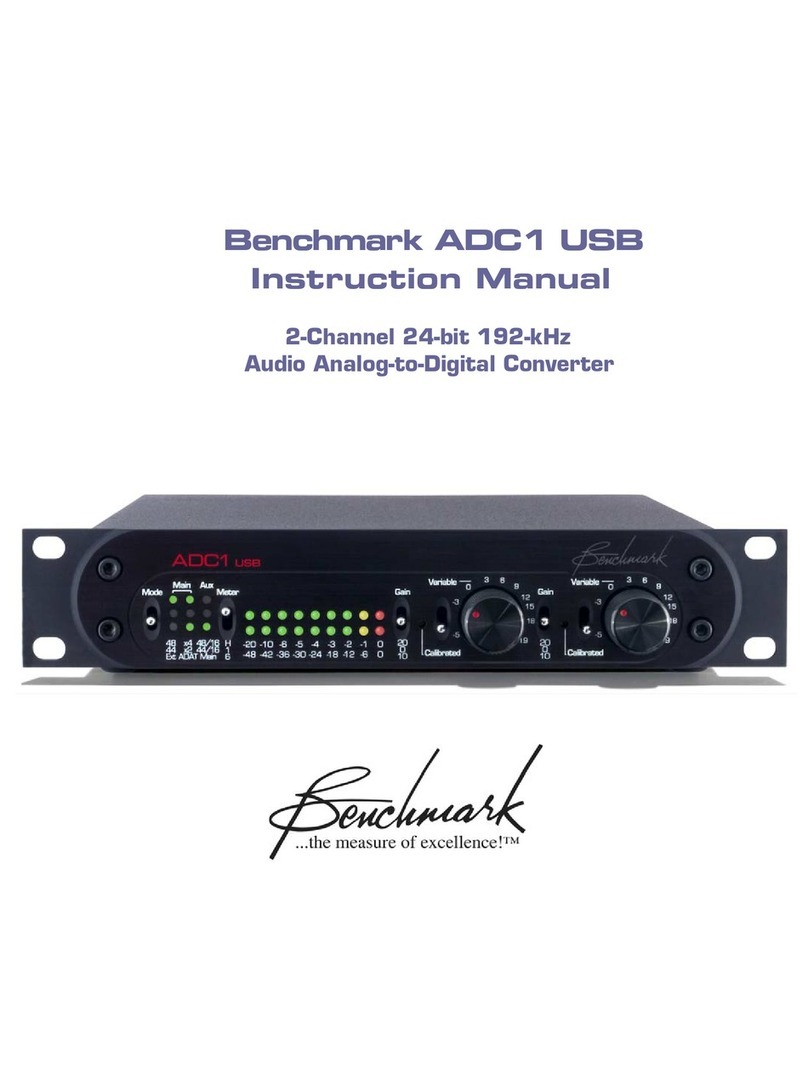
Benchmark
Benchmark ADC1 USB User manual
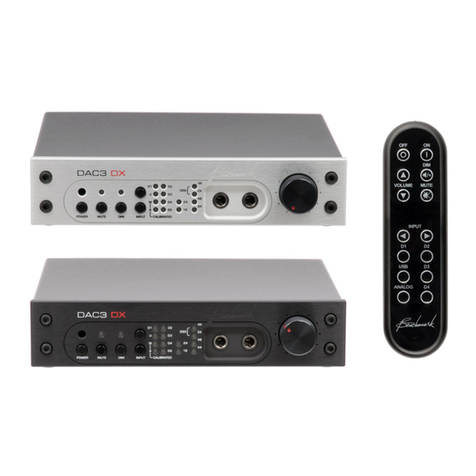
Benchmark
Benchmark DAC3 DX User manual
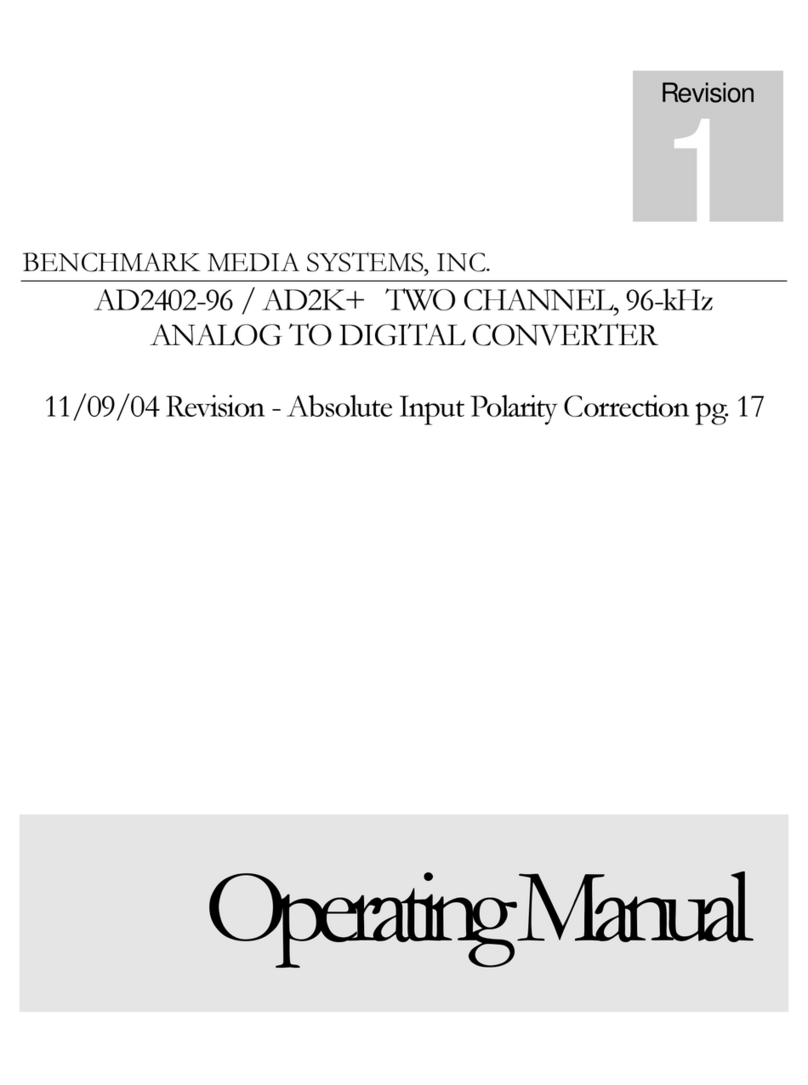
Benchmark
Benchmark AD2402-96 User manual
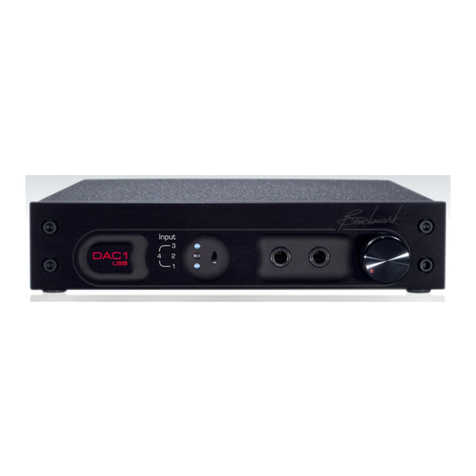
Benchmark
Benchmark DAC1 HDR User manual

Benchmark
Benchmark DAC2 DX User manual

Benchmark
Benchmark ADC1 USB User manual

Benchmark
Benchmark DAC3 HGC Quick start guide

